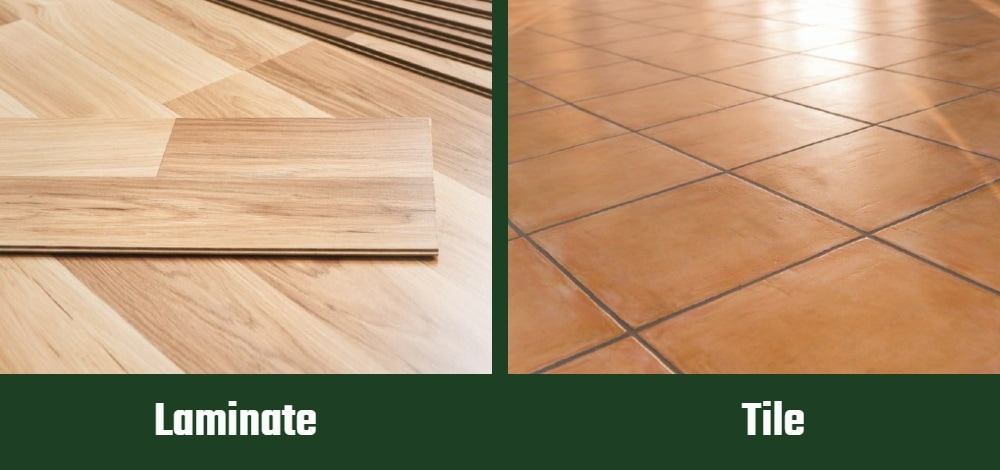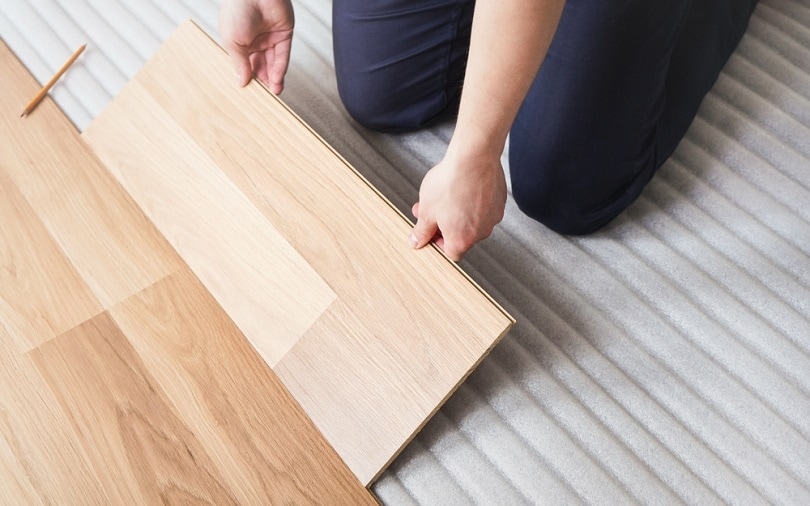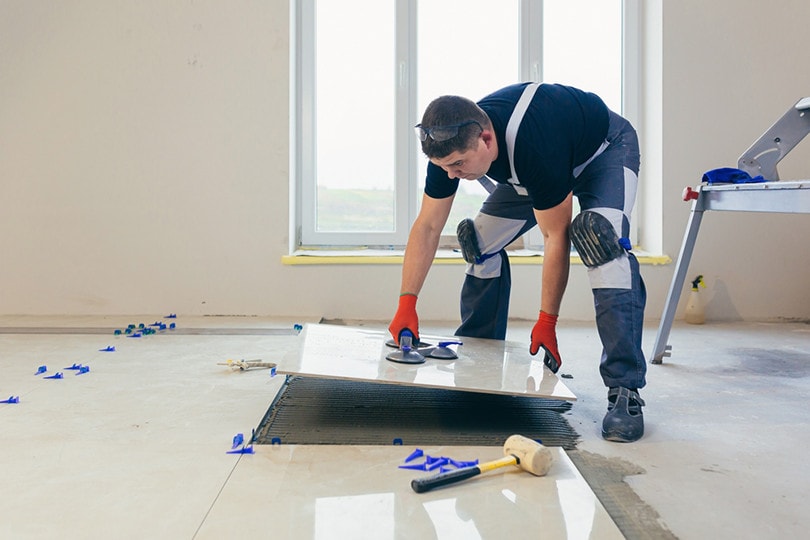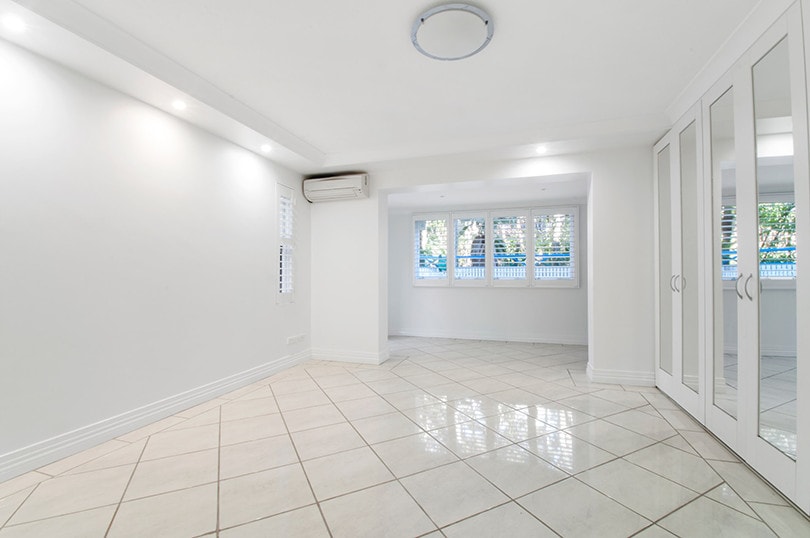Laminate vs. Tile: Pros, Cons, & Differences
-
Codee Chessher
- Last updated:

Flooring choices have expanded a lot in the past few decades, but ultimately, tile and laminate are two of the top choices. They’re both radically different types of flooring with their own pros and cons but are very popular in different markets. Let’s see what the difference between tile and laminate is and which you’ll want to use in your home.
Overview of Laminate
Laminate is a type of flooring created from wood, resin, and other compounds fused together into four distinct layers. The laminate, photographic print, high-density core, and backing layer all combine together to produce flooring that’s comfortable to walk on and can mimic other flooring types. You can get laminate to imitate stone, tile, and hardwood floors at a fraction of the cost.
The resilient laminate layer on top of the flooring provides robust scratch and impact resistance, while the core and backing layer provides durability and a layer of foam. Laminate was first mass-produced in the 1980s, and technological advances have only made production skyrocket. This makes laminate one of the most affordable flooring types available. The only bad news is that laminate only tends to last about 10–20 years, though some high-quality laminate can last as long as 30 years.

Types of Laminate
Laminate that imitates hardwood is the most common and cheapest type available, but laminate that mimics tile and stone floors is also popular. All laminate has similar easy installation, and choosing tile laminate can be a budget-friendly way to make your floors look much nicer.
Cost
Laminate is very easy to make and is plentiful at stores nationwide for a low price. On average, laminate costs $2–$8 per square foot. Combined with its robust durability, affordability makes laminate one of the top flooring choices for large floor plans and small homes alike.
Does Laminate Affect Resale Value?
Laminate typically has little to no effect on your home’s resale value, unlike tile. Laminate is prone to water damage and is so easily replaced that it adds little practical value. Stone or tile laminate may incrementally affect home value, but it’s unlikely.

When to Use Laminate
Laminate is a great choice for any room in the house. Unlike hardwood, it’s resistant against stains and scratches, which is perfect for homes with children or pets. You can use hardwood laminate for the majority of your house and add tile laminate in the bathroom. Flooring a whole home with laminate comes out much cheaper than doing the same with tile, and that’s also why large public buildings use lots of laminate.
- Affordable
- Comes in a wide range of colors and styles
- Easily installed
- Ideal for small or large spaces
- Easy to clean
- Susceptible to water damage
- Don’t add value to your home
- Doesn’t last as long as tile
Overview of Tile
Ceramic or porcelain tiles are some of the trendiest and most customizable flooring money can buy. Ceramic or porcelain goes through a four-stage firing and glazing process to become ultra-durable and virtually impervious to water damage. Tile is typically used in kitchens, where it’s perfect for catching spills and messes. Notably, tile is harder to install than laminate because it’s more firmly attached to your subfloor.
You can find nearly any color or style of tile you could imagine. There is marble, quartz, onyx, slate, granite, and many more types of tiles to choose from. This means you can mix and match various tiles to match the vibe of any room in your house. For homes that demand high-quality flooring, you can’t go wrong with tile. The only downside of tile is that it’s hard to install and more pricey than laminate, plus it can chip if you drop something heavy on it.

Types of Tiles
As we mentioned, you can find nearly any type of tile. Some are made of porcelain or clay, while others are crafted of various stones or rocks. Most have similar durability levels and water resistance, so which you choose will depend on personal preference. Most commercial tile has grout, while specialty types have a groutless design to cut down on cleaning.
Cost
Tile is significantly more expensive than laminate at $5–$13 on average per square foot. This makes tile a more sensible choice for smaller homes, while larger spaces would cost a lot to cover entirely with tile. However, it ultimately comes down to what your budget for flooring is.
Does Tile Affect Resale Value?
Yes, tile will increase your home’s resale value. This is because tile is seen as both attractive and practical for its water resistance and long effective lifespan. Depending on how much you spend on your tile, it could be a stylish investment in your home. If you spend too much on fancy tile, though, the added value will be pretty minimal.

When to Use Tile
Tile is a great choice for any room of the house, but it’s especially practical for any room with faucets, like your kitchen, bathroom, or laundry room. Instead of causing water damage like with laminate, the water will simply bead up and evaporate over time. How extensively you use tile depends, as we mentioned, on your budget. If you have a large budget, tile is a perfect choice for nearly any home.
- Super durable
- Countless colors and styles available
- Adds value to your home
- Immune to water damage
- More expensive per square foot than laminate
- Can chip or break if something heavy falls on it
- Requires grout cleaning to stay clean
Conclusion
Laminate and tile are both practical flooring choices with countless colors and styles, but which you choose mainly comes down to your budget. Laminate is cheaper to cover large spaces, while tile can be selectively used in kitchens and bathrooms or used for the whole house. Carefully choose the best flooring type for you by considering your budget and what benefits they provide to your home.
Featured Image Credit: (L) Lubo Ivanko, Shutterstock | (R) Gordine N, Shutterstock
Contents
